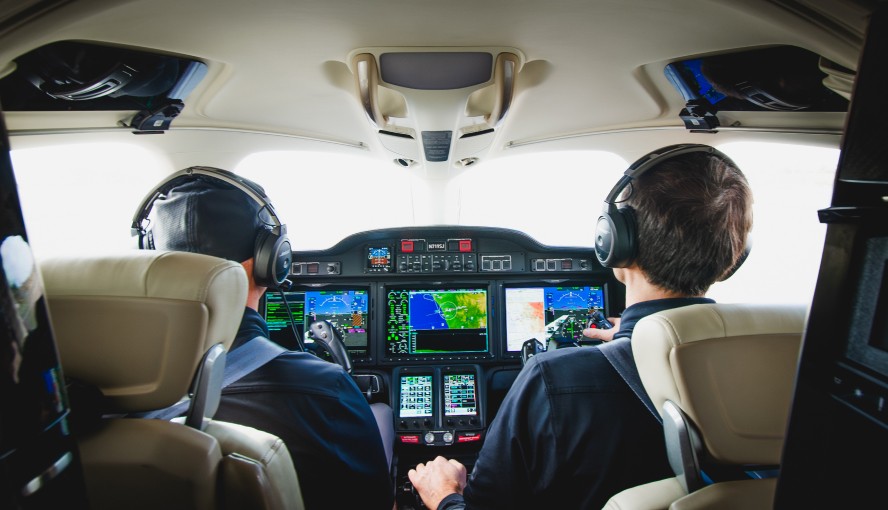It’s a bright, sunny day, not a cloud in the sky, and so far, the flight has been a smooth one. But suddenly, you hear your captain over the intercom. It’s time to fasten your seat belt and secure loose items — on board your private jet, turbulence is coming.
Yes, even in bluebird skies, you may hit an unexpected patch of turbulence. But, very importantly, a rough patch during flight is never dangerous. Flying remains the safest mode of transportation and by a significant measure.
Even if turbulence is just a typical part of the flying experience, it’s worth getting below the surface to understand the science behind it. The more you know about it, the less there is to fear.
What is turbulence?
At some point in your lifetime, you have likely experienced the sudden drop or jostle caused by a moment of mid-flight turbulence. While all too familiar, what exactly is turbulence?
Turbulence is a natural phenomenon characterized by chaotic and unpredictable eddies of air.
Surrounding environmental forces, like mountains, jet streams, and weather, are the main causes of turbulence, even within an otherwise calm airspace. These forces will cause shifts in the local airflow patterns, often causing the aircraft to abruptly change altitude.
As National Geographic explained, “Just as ocean waves break on a beach, air also forms waves as it encounters mountains […] These ‘mountain waves’ can propagate as wide, gentle oscillations into the atmosphere, but they can also break up into many tumultuous currents, which we experience as turbulence.”

There are several different causes of turbulence, which we’ll get into below, but it is a common flight event and one that pilots are fully trained to handle. For most types, pilots can anticipate and, therefore, avoid major turbulent events. But, even with the most advanced avionics, there will always be the possibility of hitting clear-air turbulence, which remains more unpredictable.
Is turbulence dangerous?
If turbulence is so common, what’s the good news in all this? Despite the discomfort it may cause, turbulence is not dangerous. In part due to continued improvements to aerospace design and advances in avionics and pilot training, modern aircraft and licensed pilots have the technology and skills to navigate turbulence safely.
What are the effects of turbulence on aircraft?
We’ve all felt it — the sudden drop or jostling from an eddy of “chaotic and capricious” airflow, as National Geographic describes it. The National Weather Service actually organizes turbulence into four distinct levels: light, moderate, severe, and extreme. With each level, they also outline the most common in-cabin experiences to expect during these events.
| Turbulence Level | Expected Effects |
|---|---|
| Light | Minor altitude/attitude changes or slight bumpiness with gentle strain against seat belts. |
| Moderate | Increased intensity of effects, which may dislodge unsecured items. Passengers will feel more strain on seat belts, but there will be no loss of control. |
| Severe | Significant, abrupt altitude changes. Strain on seat belts becomes more extreme. |
| Extreme | May violently toss the aircraft. Brief severe force on passengers, and passengers may float momentarily. Exceedingly rare, only 0.0001 percent of global flights experience this. |
Despite how a period of more extreme turbulence can feel, rest assured that these events only last for 10 to 15 minutes on average. As a passenger, it may feel like a lifetime, but in reality, it’s a brief experience with smooth sailing on either side.

Seven types of turbulence.
While mid-flight bumps may feel similar from within the cabin, there are seven distinct types of turbulence.
- Clear Air Turbulence (CAT): Occurs outside of clouds at altitudes above 15,000 feet and comes from strong wind shears in the jet stream.
- Thermal Turbulence: Develops when warm air rises in ‘pockets’ and then slowly descends as it cools, typically occurring on warm summer days due to uneven heating of the earth’s surface.
- Temperature Inversion Turbulence: Results from stable atmospheric conditions where an inversion causes turbulence within the boundary between the inversion layer and the surrounding atmosphere.
- Mechanical Turbulence: Created when the air near the earth’s surface flows over obstructions like hills, mountains, or buildings, disrupting the normal horizontal wind flow.
- Frontal Turbulence: Caused by the lifting of warm air by a frontal surface between warm and cold air masses, leading to instability and turbulence in the frontal zone.
- Mountain Wave Turbulence: Forms when air flows over mountains, creating standing mountain waves with oscillating air currents that may extend for hundreds of miles downwind.
- Thunderstorm Turbulence: Associated with turbulent vertical motions in thunderstorms, with updrafts and downdrafts extending outside the storm, causing severe turbulence as far as 15 to 30 miles downwind.

As mentioned above, pilot training and the avionic equipment packed into the cockpit of modern aircraft can help aircraft avoid most types of turbulence. Yet, certain types, particularly clear air turbulence, are more difficult to predict and, therefore, avoid.
Safety tips for private jet passengers during turbulence.
As soon as the seat belt light comes on and the pilot gets on the speaker, it usually means a pocket of rough air is coming up. These two signals are what most of us associate with turbulence.
Follow instructions from pilots and crew
The number one rule is to always listen to the directives issued by the pilot and crew. When pilots foresee a pocket of rough airspace, they are trained to give the crew and passengers as much advance notice as possible.
You may hear the captain (or sometimes the chief flight attendant) use the intercom to advise passengers to sit down, buckle up, and secure loose items. If you hear this, it’s for good reason, and you’ll want to follow their instructions.
Keep your seat belt fastened
The Federal Aviation Authority mandates that passengers are belted up for take-off, landing, and whenever the fasten seat belt sign lights up.
Otherwise, it’s a good idea to have your seat belt fastened when seated in case of a sudden turbulent event.
Secure loose items
When turbulence is expected, it’s time to put away your in-flight office and scattered toiletries you may have left in the lavatory. Even during mild to moderate turbulence, unsecured items risk getting tossed around.
Yes, your cell phone might survive falling from a table, but what happens if it hits you or your fellow passengers? The real risk of unsecured items is causing injury to those in the cabin rather than the items themselves.
Try to keep calm
As a pilot and 23-year veteran of the Air Force told AARP in an interview about turbulence, “I know it’s scary when the plane is shaking while you’re 35,000 feet in the air. Just keep in mind that your pilot is not concerned, so you shouldn’t be either.”
A sudden drop in altitude can feel unnerving, yet turbulence is a natural element of flying. For pilots especially, it’s just a small and expected bump on the road. If you see the seat belt sign, come on, try to stay calm, take slow, deep breaths, and know it will pass in just a few minutes.
How private jet pilots navigate through turbulence.
Pilots, whether flying a private or commercial aircraft, have a suite of tools and skill sets to help avoid or reduce the impacts of turbulence.
First, pilots communicate with other aircraft, sharing information and warnings about potential pockets of turbulence. This allows pilots to deviate from the flight course or adjust altitude to avoid these known rough patches. They can also slow down the aircraft to reduce the impact of these forces.
Another way to reduce weather-caused issues (temperature inversion, thermal or thunderstorm turbulence) is through advanced weather radar systems that monitor conditions. Pilots may also receive information from dispatchers and meteorologists on the ground to help plan the smoothest route based on current atmospheric conditions.

Mechanical or mountain wave turbulence may be one of the easiest predictions because these large structures are stationary and constant. The impact they have on the surrounding atmosphere and weather is very predictable, which means it is avoidable.
Private jets and turbulence: A final note.
Pilots use advanced technology, expertise, and adherence to safety protocols to ensure passenger comfort and safety during periods of turbulence. Mild and moderate levels of turbulence are just a common experience on board most flights, both commercial and privately operated.
As a Volato passenger, you are in good hands. We follow all FAA regulations for navigating turbulence but go even further to keep our passengers safe, as reflected by the achievement of our ARGUS Platinum, IS-BAO Stage 3, and Wyvern safety ratings. Your safety is our priority.
Questions about Volato? We’d love to hear from you. Contact us today.
Turbulence FAQs
Can turbulence cause damage to the aircraft?
In rare cases, extreme turbulence may cause damage to the aircraft, but according to an NPR report, this is mostly in-cabin damage rather than to the exterior.
Is turbulence more common during certain times of the year?
Specific types of turbulence are more common during certain times of the year. For example, thermal turbulence often occurs on summer days when warm air rises in ‘pockets’ and then gradually cools as it descends. This is because the earth’s surface heats unevenly, forming these hot weather pockets.
How do private jet pilots ensure passenger safety during turbulent conditions?
Private jet pilots follow all FAA regulations on turbulence to ensure that passengers stay safe should unexpected turbulence arise during their flight. Private jet operators may also add training and safety certifications to their programs that go above and beyond.
Volato has obtained ARGUS Platinum and IS-BAO Stage 3 safety ratings. We also ensure our pilots receive adequate rest periods, because our top priority is the safety of our passengers and crew.
Do private jets have more turbulence?
With millions of private jet flights, a year in the US alone (over 4.6 million private jet flights in 2022), it’s impossible to make a blanket statement about whether private jets feel the impact of turbulence more than their commercial counterparts. Jet size, route, altitude, time of year, and weather impact turbulence — not whether it’s a private jet.